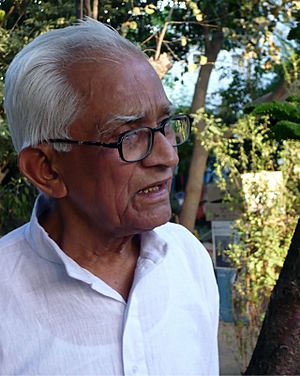Amritlal Vegad facts for kids
Quick facts for kids
Amritlal Vegad
|
|
|---|---|

Vegad in 2013
|
|
| Native name |
अमृतलाल वेगड़
|
| Born | 3 October 1928 Madhapar |
| Died | 6 July 2018 (aged 89) Jabalpur |
| Occupation | Writer, essayist, poet |
| Nationality | Indian |
| Subject | Gujarati Hindi |
Amritlal Vegad (born October 3, 1928 – died July 6, 2018) was a famous Indian writer and painter. He wrote in both Gujarati and Hindi languages. He lived in Jabalpur, a city in Madhya Pradesh, India.
About Amritlal Vegad
Amritlal Vegad was born into a family from a village called Kumbhariya in the Kutch region. His father, Govamal Jivan Vegad, was a railway contractor. This means he helped build railway lines.
His family belonged to the Mestri community, which is known for being hardworking and good at business. His father settled in Jabalpur in 1906. He was working there to build railway lines for the Bengal Nagpur Railway company.
His Education
Amritlal Vegad studied at Visva Bharati University in Santiniketan. He was there from 1948 to 1953. He learned from amazing teachers, including Nandalal Bose. From them, he learned to truly appreciate nature and its beauty.
He was trained to paint with watercolours, but he also used oil paints. After finishing his studies, he returned to Jabalpur. He became a teacher at the Institute of Fine Arts there. A story he wrote as a student was later published in a famous book called Gandhi-Ganga in 1968.
Amritlal Vegad passed away on July 6, 2018.
His Amazing Work
Amritlal Vegad received many awards for his writing. In 2004, he won the Sahitya Akademi Award for his travel book. This book was called Saundaryani Nadi Narmada. He also won the Madhya Pradesh Rajya Sahitya Award and the Rashtrapati Award. He even received the Mahapandit Rahul Sankrityayan award for his Hindi writings.
His most well-known books are about his journeys along the Narmada River. These include Narmada-ki-pari-krama in Hindi. In Gujarati, he wrote Saundaryani Nadi Narmada and Parikramā Narmadā maiyānī. He also wrote folk tales and essays in Gujarati, like Thodun sonun, thodun rupun. Other books are "Amritasya Narmada" and "Teere Teere Narmada". These books have been translated into several languages, including English and Bengali.
Amritlal Vegad wrote these books based on his own walking trips. He walked along the banks of the Narmada River for over thirty years. He started his first long walk, known as a parikrama (a special kind of journey around a holy place or river), in 1977. He was 49 years old then. His last parikrama was in 1999, when he was 71.
He walked the entire length of the river. This was from its starting point at Amarkantak to where it flows into the sea near Bharuch. His wife joined him on all his travels. She carried her own bags during these long journeys.
His books are special because they include his own sketches and collages. He made these drawings and artworks during his travels. Art critics have praised his artwork as beautiful and unique.
Amritlal Vegad was also an important environmental activist. He cared deeply about rivers like the Narmada. He spoke out about the pollution in these rivers in Madhya Pradesh. He was the president of Narmada Samagra. This group works to stop river pollution. They also try to improve public toilets and bathing areas along river banks. This helps keep the rivers and their surroundings clean.

